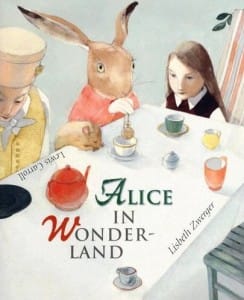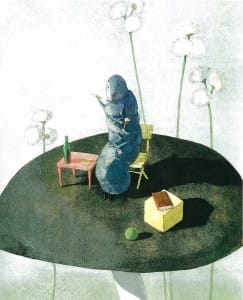I wish to register a complaint. Five years have passed since we were subjected to that disturbing image of you as Willy Wonka in Charlie & the Chocolate Factory. I had hoped that by now you would have moved beyond children’s literature in favour of something better suited to your predilections, like artistic director at Neverland Ranch.
However, with the release of Alice in Wonderland it appears that we are to be afflicted with yet another tiresome, fetishistic take on a classic literary character. I have not seen the movie, but I have seen enough to know that your visual interpretation of the Mad Hatter is creepy. Not inspired, not delightful, not even whimsical, just creepy. Alice’s Adventures in Wonderland is indeed, a strange book, and in the 145 years since its publication in 1865, it has proven time and again to be a deep rabbit-hole of inspiration for artists of all persuasions, including actors. And now, I suppose it’s your turn.
This is not to say I haven’t enjoyed some of your films, especially the tastier ones like Chocolat and What’s Eating Gilbert Grape, but I have come to the conclusion that you must be bored, and for reasons better left unexplored, extreme makeup does it for you. It amuses you, and it amuses your partner in cosmeticological crimes, Tim Burton.
But public self-gratification does not amuse me, most of the time, and I think it would be a mistake to regard your affectations as anything but self-serving.
You sir, are a creeper, as my nieces would say.
However, not to despair, there are many examples of inspired illustrative interpretations of Alice’s Adventures in Wonderland, and the best of these is by Lisbeth Zwerger.
Like Arthur Rackham a century before, Lisbeth Zwerger is considered the master of classic children’s picture book illustration, with a range that spans the Brothers Grimm to the Nutcracker. Born in Vienna in 1956, Zwerger has illustrated more than 40 books, and been awarded every accolade available to great illustrators, including the Hans Christian Andersen award in 1990, the children’s literature equivalent of the Nobel Prize, and most recently, inclusion in this blog. I first ran across her work in 1982, in an edition of The Gift of the Magi. Incidentally, the book was $12.95, which is half the price picture books are today. Also, my copy has teeth marks on the bottom right corner, thanks to a family pet who was no lover of short stories, especially those penned by O Henry. I just pretend it’s an elaborate die-cut.
Magi is Zwerger’s eighth book, and unlike her previous seven, which exhibit a more traditional, sepia-infused style, The Gift of the Magi is a feather light confection. It marks a turning point in her career, and all of her subsequent work builds on this growing mastery of jewel-box colours, unconventional composition, and a playful, often macabre sense of humour. Alice in Wonderland is therefore, a perfect vessel for Zwerger’s virtuoso talent.
Published in 1999, Alice features offbeat and beautiful interpretations of familiar characters, including yes…the Mad Hatter with a potato pot on his head and Alice, studious and maybe a little downcast in her school girl tie and red stockings. There are several paintings of the Cheshire Cat throughout the book, and in all of them his tomato-red face and deranged grin reminds us that this is a curious world Zwerger has revealed to us, but in her deft hands, not so strange that we won’t follow her down the rabbit-hole.
However, the thing that distinguishes Zwerger from her contemporaries is the ability to pull out obscure details and minor characters, some real, some imagined, and breathe life into them with her brush. Her illustrations are never overcrowded with meaningless detail, but every face from the White Rabbit’s to the Blue Caterpillar’s, every mouse-tail, even the pattern on the Mad Hatter’s vest has the exquisite finish of a master craftsman. Or is that person? Ah well, you know what I mean. She’s good. Very, very good.
Burrowing ever deeper into the rabbit-hole, you may run into an ape or two, if you’re lucky, which would mean you’ve entered the wondrous world of Anthony Browne, English illustrator and exemplary Alice intepreter.
Like Zwerger, Anthony Browne is an artist who has been working for a very long
time, and while he can lay claim to an impressive list of self-authored publications, Browne occasionally dabbles in the classics, especially when there is opportunity to include one or two drawings of a gorilla. In fact, thanks to Mr Browne, I have been surprised at how many children’s classics have ape-centric story lines, and indeed, there is a gorilla in his version of Alice’s Adventures in Wonderland, published in 2003. Like Zwerger, he works primarily in watercolour, but with a heavier, hairier hand. It’s that monkey thing. More about him later.
Lisbeth Zwerger and Anthony Browne have certainly added their own particular and peculiar charms to the Lewis Carroll oeuvre, but don’t discount the original John Tenniel illustrations, especially if you can find the William Morrow edition from 1992, which was printed from the original woodblocks found in a bank vault in 1985 in London. Tenniel’s illustrations have become part of our visual vernacular, and in these fresh and sparkling prints, he is clearly Lewis Carroll’s equal as one of the 19th century’s most iconic, if not loopiest visionairies.
Alice in Wonderland by Lewis Carroll, illustrations by Lisbeth Zwerger North-South Books, 1999
Alice’s Adventures in Wonderland by Lewis Carroll, illustrations by Anthony Browne Walker Books, 2003
Alice’s Adventures in Wonderland by you know who, illustrations by John Tenniel William Morrow, 1992
Alice in Our Own Private Wonderland by Mr Burton and Mr Depp, 2010







Yes, thanks to Tim Burton for getting his sticky, mannered fingers all over yet another childhood favourite, eh? There are few more overrated directors, I think. A terrific art director, maybe, but then all his films look the same, so…
I really like the Browne Alice – must track down the Zwerger, as well..